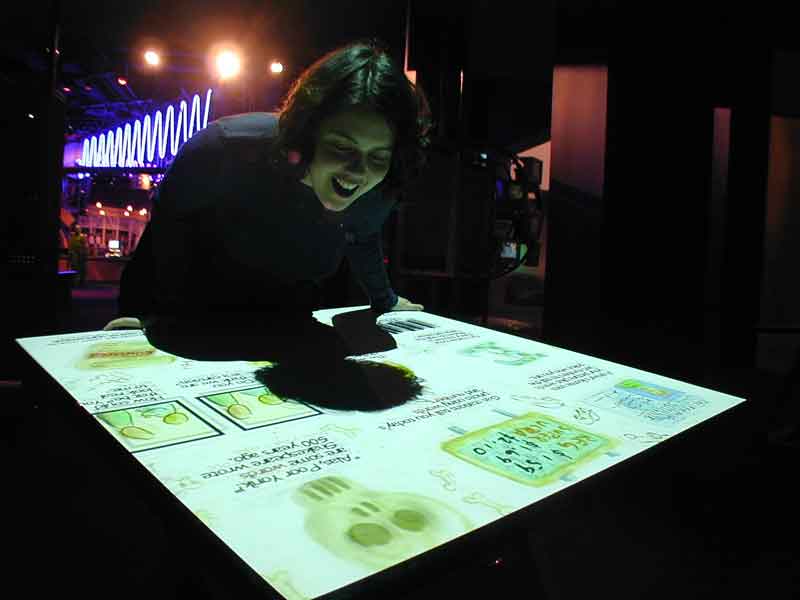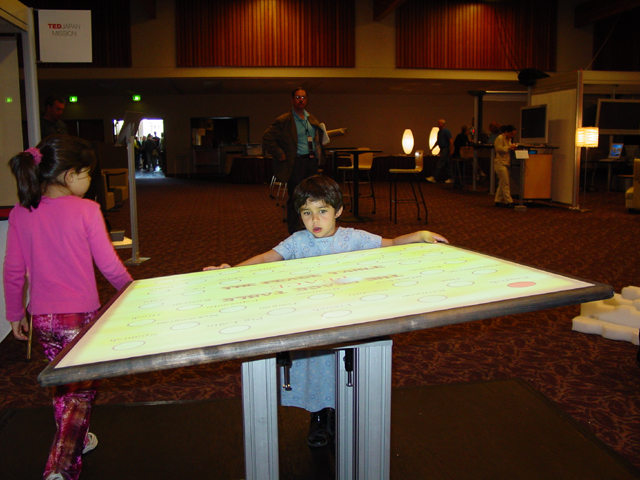[Status: Draft]
Related Categories: Hardware Innovations | Alternative Interfaces | New Reading Interfaces Working Group
Summary:
Designed by the RED (Research in Experimental Documents) group at Xerox PARC, Tilty Tables was an experiment for the museum installation, eXperiments in the Future of Reading (XFR; Maribeth Back, Rich Gold, Anne Balsamo, Mark Chow, Matt Gorbet, Steve Harrison, Dale MacDonald, Scott Minneman, 2001), which was also exhibited for SIGGRAPH 2001 Emerging Technologies. Of the three tables developed, The Reading Table and The Tall Tale Table shall be addressed here. Each table is a three-by-three-foot-wide white square resting on a metal podium, attached in such a way as to allow it to be tilted in all directions. A high-resolution image is projected onto the table’s surface, which gives the appearance that the table is a glowing screen. When visitors tilt the table the images on its surface change in response. With The Reading Table, visitors glide across a large “map” of “napkin drawings” on the subject of future reading practices. The Tall Tale Table resembles the conception of an unlimited and cyclical universe of books from the Jorge Louis Borges’ story “The Library of Babel”; it presents an infinite plane of nonsense tall tales, constructed using a simple computer program with the input of two real fairy tales from various cultures.
Description:
The Reading Table allows the visitor to move through a large document that, if it were to be printed out, would be over thirty-by-thirty-feet. The Table frames a small section of the image such that when the surface is tilted, the window slides across the document (or, rather, the large document slides under the window). The result is that the visitor feels as if she is surfing or gliding across the image. The document is like a large laboratory notebook or “napkin drawing,” containing hundreds of colorful cartoons exploring many different ideas about “reading,” “writing,” “words” and “telling” that the researchers sketched while thinking about the Experiments in the Future of Reading exhibition.

The Tall Tale Table presents an infinite plane (the visitor can go forever in any direction) of nonsense Tall Tales. Each of these Tall Tales is constructed using a simple computer program whose input is two real fairy tales. The names and origins of these fairy tales are listed beneath each Tall Tale. The Tall Tales appear scrambled, and most do not make much sense, although occasionally they appear to follow a narrative.

Research Context:
As RED asserts, reading is generally thought of as low-energy, static, solitary, and contemplative, engaging the mind more than the body. The group wanted visitors to think about how the body can be engaged in the act of reading, especially when reading large documents. The Tables are designed to engage the body with text and require very little instruction to use. As Matt Gorbet stresses, there is very little learning curve, no right or wrong way to interact, and no instructions need to be given; the Tables employ short forms of text such as poetry, quotations, and symbols, which “are effective because they can be quickly grasped and have immediate impact, allowing visitors to start reading anywhere and spend as much or as little time as they like with the piece” (First Person, 219-21).
The Reading Table explores how one may read extremely large documents in new ways. This technique, for instance, could also be used in reading blueprints or large maps. As in its other exhibits, RED is exploring how words and images work together to form meaning. The Reading Table examines how we use our bodies when we read and how that might effect the meaning of the words. Standing and tilting The Reading Table, for example, is different than sitting and turning the pages of a book. (See XFR Guide to the Exhibit)
As a preliminary investigation into how the reader responds to computer-authored text, The Tall Tale Table demonstrates how a “pile of words” might transform and combine into a “story,” as well as what it feels like to explore an infinite plane of stories that extends forever. (ibid.)
Technical Analysis:
The following technical analysis is taken directly from the XFR “Guide to the Exhibit”:
The tables sit on pneumatic shock absorbers, much like the ones used in cars to smooth out the ride. Also under each table is a digital device called “an accelerometer” which measures how quickly something is getting faster or slower. (Acceleration means rate of change. For example, a car going from 0 to 60 is accelerating. A car moving at a steady 60 miles per hour is not accelerating at all.) As it turns out, an accelerometer can also measure tilt, much the same way that the bubble in a carpenter’s level can measure tilt. This is because gravity is really acceleration (as Newton discovered 400 years ago). The tilt information from the accelerometers is sent to computers that use this information to determine the correct image to send to the video projectors. These projectors are mounted in the ceiling and are precisely aligned with the tables beneath them so that the images fill the white surface of the tables.The Reading Table: The large image was drawn with a computer drawing program called “Fractal Design Painter.” The final image is approximately 5000 by 5000 pixels in size. The computer “wraps” the image so that if you go off the top of the image, you smoothly end up at the bottom. Likewise if you scroll off the left, you find yourself on the right, and vise versa. (A surface that works this way is called a “torus” and looks like a doughnut if you could see it.)
The Tall Tale Table: In English, as in all other languages, only certain words follow other words. You might see: “The red dog” but you will never see: “Dog red the.” Given a story such as “Little Red Riding Hood” one can make a chart of all the words that can follow other words in that story. In many cases it is possible that more than one word can follow a given word. Once a word chart has been constructed, new stories can be created combining words together that can follow other words. This is done by picking a word to begin with and finding another word that grammatically or semantically can follow after it. After the first pair of words are combined, the combination process continues until a chain of new word combinations is constructed to form a story of sorts. The scientific name for this is a “Hidden Markov Chain.” Each of the constructed stories in The Tall Tale Table is derived from two of seventy-two real folk tales from around the world. The two stories have been added together when the computer constructed the “word chart,” thus the visitor can tell which words come from which story by their color. The computer generates the stories in real time as the visitor tilts the table but in such a manner that if the visitor returns to the same place on the plane they will see the same story.
Evaluation of Opportunities/Limitations for the Transliteracies Topic:
As the Tables move in all directions on a tilting horizontal plane, the body’s spatial relation to text is explored, and text is no longer conceived or presented linearly. Reading these surfaces requires not simply the scanning of the eye from left to right, but a broader engagement with the entire body, which bends over the surface, tilts the plane with arms and back. Scale plays an integral role in the physical and conceptual aspects of reading these Tables; not only is the Table’s surface larger than the average book or computer screen, the texts and images themselves are infinite (yet bounded)–one never reaches a terminal point, but rather continues through the “torus” or through an endless combination of words. The text of the Tall Tale is not fixed but is in a constant cycle of reconfiguration, which not only generates a new narrative upon each reading, but also challenges any notion of authorship. While the oral folk tradition associated with tall tales problematizes the author function, this computation and synthesis of two tales further challenges notions of origin and intention.
In exploring how one might navigate a vast terrain of text, The Reading Table offers information that is spread out upon a single plane. Rather than conceptualize various “files” or “documents” as stacked “one behind the other,” as evident in the GUI of the personal computer–which has a relatively small and vertical screen–The Reading Table constitutes a vast landscape to wander across–perhaps less systematic than the files on the desktop computer, but nonetheless intuitive. Indeed, the Tables are designed to be immediately comprehensible, requiring little or no outside cues or instruction as to how to navigate the interface. These works may require little time to understand and appreciate, yet it is unclear the degree of “depth” they can offer or the length of time a visitor is willing or able to dedicate to such an interface. Indeed, if these Tables succeed in engaging the visitor as a fully embodied reader because the works are in some way immediate and brief, one wonders, as does Matt Gorbet (2004: 221), if it is possible to create a body-centric interactive piece with the storytelling capacity of an epic novel or a play. It is apparent that the reader is unlikely to spend several hours in a physically demanding or disorienting interaction; what may be “fun” for a few minutes in an exhibition space may certainly not be effective as a research tool or work space. However, one is not expected to systematically organize the “napkin drawings,” or discern a clear “meaning” from the Tall Tales; in playing with these Tables, reading is conceived as play; there is no impetus upon the reader/visitor to produce anything from this encounter–these Tables are not concerned with end-results; the Tables leave the visitor with impressions, with sketches, and with bits of nonsense. As a flat and mobile plane, the Tables emphasize the play of reading as an immediate yet infinitely absorbing surface.
Resources for Further Study:
- Harrison, Steve, et al. “Design: The what of XFR: eXperiments in the future of reading.” Interactions. 8.3 (2001): 21-30.
- Back, Maribeth, et al. “Designing innovative reading experiences for a museum exhibition.” Computer. 34.1 (Jan 2001): 80-87.
- Gorbet, Matt. Response to “Unusual Positions–Embodied Interaction with Symbolic Spaces” (Camille Utterback). First Person: New Media as Story, Performance, and Game. Eds Noah Wardrip-Fruin and Pat Harrigan. Cambridge: The MIT Press, 2004. 218-22.
- Gorbet Design, Inc. article on XFR
- Onomy Labs article on Tilty Tables
- XFR Guide to the Exhibit
- Shanks, Michael. “Materialities of Media.” Weblog 8 Oct 2003.
- http://seminars.seyboldreports.com/2000_san_francisco/files/24/24_transcript.html
